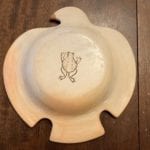9.6875″ tail-to-head crest
Joy Navasie (1919-2012) was a prolific potter of kaolin white-slipped vessels like the bird plate discussed here. However the avian shape of this plate is unusual, perhaps unique. Generally white-slipped pottery seems stark and cold to me and thus there is only one other Joy Navasie pot in this collection (1992-09). However some of the core clay of plate 2019-25 blushed gold when fired and the resulting gentle white finish and variation in color catches my eye, as did the vessel form. Beautifully proportioned, regally decorated and smiling, this bird has personality.
The plate is a bit more than 0.25″ thick and thus feels substantial when lifted. The circular depression is about 6″ in diameter. The tail has three wide and shallow grooves. Cigarette ashtrays sold well to tourists throughout the 2oth century and are a common item. (cf 2011-32, 2017-12 and 2019-01.) The size of the plate and the three tail groves suggest that this avian tray may have been made as a cigar ashtray, perhaps made on commission. If so, it was never used. The frog identification mark on the bottom has webbed feet and is thus attributed to Joy rather than her mother Paqua Naha, whose frog signatures had pointed toes. (See cf 2001-05 and 2014-03.)
Joy formed a wide flange around the circular center and then cut away portions to leave a head and a tail and two wings. The head and tail project about 2.0 inches from the edge of the circular center, the two wings about 1.5 inches. The head is a long smooth curve from the back of the neck to the beak, then reverses itself at the point of the beak to form a short chin. About 0.5 inches of the beak is painted with a reddish-orange paint, a thick black line indicating the separation between upper and lower sections. This same pattern is repeated on the rear of the plate, making the beak the only painted element on the underside of the plate, aside from Joy’s identification mark. A round circle with a central dot indicates the eye.
Joy drew a 5.5″ black line on each wing along the edge of the circular depression and the same seven elements of design were then drawn on both wings in sequence along this line. At the top are four parallel black lines pointing to the head. They emerge from the side of a simple greek key that terminates with a three-step form. These elements may represent water, swirling and falling. The greek key emerges from a set of three parallel lines (a “two-lane highway”), a form often used by Nampeyo and later Sikyatki Revival potters to separate sections of design. Based on this highway, a set of three fins point towards the tail. Black-edged and painted reddish-orange, they vary in shape: the longest and narrowest fin abuts the black line along the edge of the circular center. At the point of this fin, a solid black half-moon begins. Parallel to its flat base are two parallel lines in an unpainted area, a “three-lane highway.” Finally, based on this highway, are another set of three fins, solid black, more elongated and thinner than the reddish-orange set above.
Lydia Wycokoff explains a design strategy that she calls calls”figure-ground reversal…when you look at the pot, the figure and the background against which it is placed keep changing places, the figure becomes the background and the background becoming the figure (1985: 100-102).” This eye trick was employed by Joy on plate 2019-25. Notice that both the reddish-orange and the black sets of downward pointing fins can either be viewed as simply painted on a blank surface or can be viewed as interlocked with two sets of upward pointing, unpainted fins. The eye jumps between these two perspectives, enlivening the design.
Moreover, this effect is used with particular impact to indicated three white feathers on the tail of the bird. The feathers are defined by a surrounding black element with four points; paint that defines where the white feathers are not. First the viewer’s eye sees the curiously-shaped black tail element, then switches to seeing the three embeded white feathers. Note that these feathers are painted on a shelf of clay that angles out from the body, as do the white feathers. Thus both the physical form of the tail and the painted feathers reinforce each other to create an expansive visual imagery. It’s a complicated tail…
To summarize: the cut-out shape of this plate first attracts a viewer’s eye. Then the three reddish-orange elements form a visual triangle that centers the eye and integrates the design. The black elements are dark and solid, in vibrant contrast to the white slip. The background reversal of the tail feathers and the flaring of the tail flange further energize the design. Color and shape work together to give this perky bird a lively personality.




